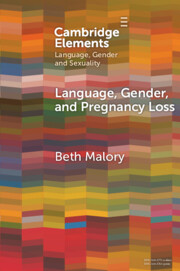Refine search
Actions for selected content:
141 results

Language, Gender and Pregnancy Loss
-
- Published online:
- 21 October 2025
- Print publication:
- 13 November 2025
-
- Element
-
- You have access
- Open access
- HTML
- Export citation
Claiming Citizenship: The Political Labor of Black Women’s Resistance
-
- Journal:
- Du Bois Review: Social Science Research on Race , First View
- Published online by Cambridge University Press:
- 08 October 2025, pp. 1-21
-
- Article
-
- You have access
- Open access
- HTML
- Export citation

Applying Corpus Linguistics to Illness and Healthcare
-
- Published online:
- 05 September 2025
- Print publication:
- 25 September 2025
-
- Book
-
- You have access
- Open access
- Export citation
4 - ‘Listen When I Flip the Linguistics’: Linguistic Approaches to Rap and the Case of 2Pac
- from Part II - Approaches to Rap
-
-
- Book:
- The Cambridge Companion to Global Rap
- Published online:
- 25 July 2025
- Print publication:
- 14 August 2025, pp 72-87
-
- Chapter
- Export citation
Autonomy and the Governance of ‘Ageing in Place’
-
- Journal:
- Social Policy and Society , First View
- Published online by Cambridge University Press:
- 08 May 2025, pp. 1-14
-
- Article
-
- You have access
- Open access
- HTML
- Export citation
11 - Disinformation and Algorithms
- from IV - Persuasion and Algorithms
-
-
- Book:
- Manipulation, Influence and Deception
- Published online:
- 10 June 2025
- Print publication:
- 24 April 2025, pp 223-249
-
- Chapter
- Export citation
6 - Hacks, Fakes, and Hot Takes
-
-
- Book:
- Governing Misinformation in Everyday Knowledge Commons
- Published online:
- 13 March 2025
- Print publication:
- 20 March 2025, pp 123-147
-
- Chapter
-
- You have access
- Open access
- HTML
- Export citation
Introduction
-
- Book:
- The Politics of International Norms
- Published online:
- 07 February 2025
- Print publication:
- 20 February 2025, pp 1-37
-
- Chapter
- Export citation
6 - Norm Clarification
-
- Book:
- The Politics of International Norms
- Published online:
- 07 February 2025
- Print publication:
- 20 February 2025, pp 261-298
-
- Chapter
- Export citation
Norm contestation and framing strategies: the home rule movements in Taiwan and Korea during Japan’s colonial era
-
- Journal:
- Japanese Journal of Political Science / Volume 25 / Issue 4 / December 2024
- Published online by Cambridge University Press:
- 04 February 2025, pp. 223-246
-
- Article
-
- You have access
- Open access
- HTML
- Export citation

Pride in Asia
- Negotiating Ideologies, Localness, and Alternative Futures
-
- Published online:
- 17 January 2025
- Print publication:
- 13 February 2025
-
- Element
- Export citation
Teachers’ articulations of digital resources in an upper secondary programme for newly arrived migrants
-
- Article
-
- You have access
- Open access
- HTML
- Export citation
Topos of threat and metapolitics in Russia’s securitisation of NATO post-Crimea
-
- Journal:
- Review of International Studies / Volume 51 / Issue 4 / July 2025
- Published online by Cambridge University Press:
- 13 January 2025, pp. 649-668
- Print publication:
- July 2025
-
- Article
-
- You have access
- Open access
- HTML
- Export citation
Chapter 1 - What Is Discourse?
-
- Book:
- Introducing Practical Discourse Analysis
- Published online:
- 20 December 2024
- Print publication:
- 09 January 2025, pp 1-42
-
- Chapter
- Export citation
Chapter 4 - What Is the Role of Context in an Analysis?
-
- Book:
- Introducing Practical Discourse Analysis
- Published online:
- 20 December 2024
- Print publication:
- 09 January 2025, pp 97-126
-
- Chapter
- Export citation
Chapter 3 - What Are the Perspectives and Levels of an Analysis?
-
- Book:
- Introducing Practical Discourse Analysis
- Published online:
- 20 December 2024
- Print publication:
- 09 January 2025, pp 67-96
-
- Chapter
- Export citation
Chapter 2 - What Is an Analysis?
-
- Book:
- Introducing Practical Discourse Analysis
- Published online:
- 20 December 2024
- Print publication:
- 09 January 2025, pp 43-66
-
- Chapter
- Export citation
Chapter 5 - What Is the Role of the Researcher in an Analysis?
-
- Book:
- Introducing Practical Discourse Analysis
- Published online:
- 20 December 2024
- Print publication:
- 09 January 2025, pp 127-156
-
- Chapter
- Export citation
Chapter 7 - A Model for Doing Discourse Analysis
-
- Book:
- Introducing Practical Discourse Analysis
- Published online:
- 20 December 2024
- Print publication:
- 09 January 2025, pp 179-204
-
- Chapter
- Export citation
Chapter 6 - What Is the Role of Theory in an Analysis?
-
- Book:
- Introducing Practical Discourse Analysis
- Published online:
- 20 December 2024
- Print publication:
- 09 January 2025, pp 157-178
-
- Chapter
- Export citation
